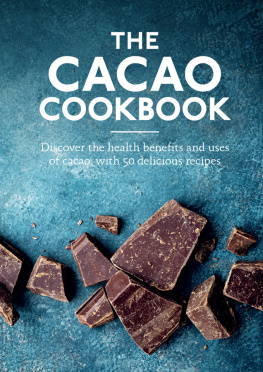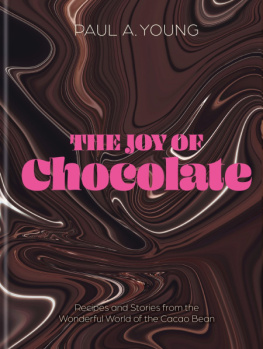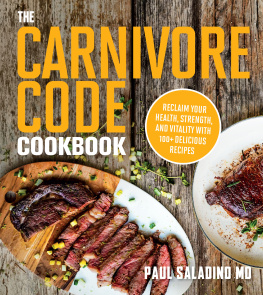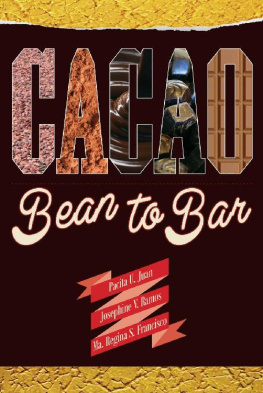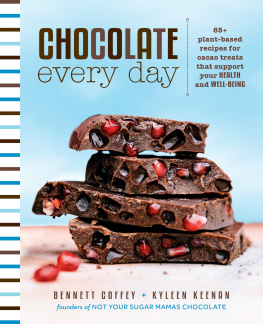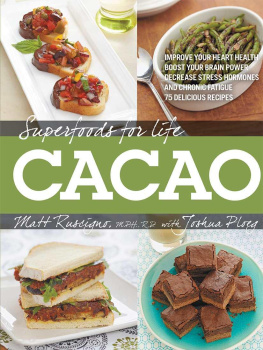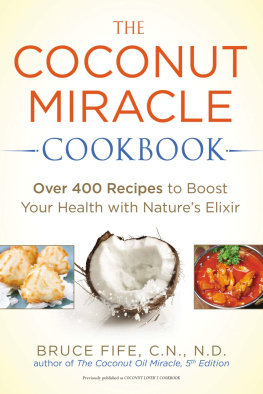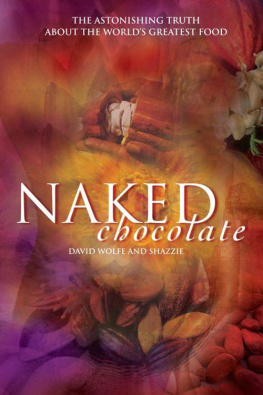Contents
Guide


CONTENTS
HOW TO USE THIS EBOOK
Select one of the chapters from the and you will be taken to a list of all the recipes covered in that chapter.Alternatively, jump to the to browse recipes by ingredient.Look out for linked text (which is in blue) throughout the ebook that you can select to help you navigate between related recipes.You can double tap images to increase their size. To return to the original view, just tap the cross in the top left-hand corner of the screen.INTRODUCTION
Cacao, or Theobroma cacao(Greek for food of the gods), is the source of original, natural chocolate. Cacao as an ingredient comes from the seeds of the fruit of the cacao tree and has been revered by the indigenous peoples of South America, or Mesoamerica (which includes Mexico, Central America and South America) as far back as 1600 BC .Before cacao was cultivated as a crop, it was used in rituals including religious ceremonies, births, marriages and funerals, and as a medicine. As it became a type of currency, cacao began to be cultivated, especially by the Mayans around 600 AD .Columbus was the first European to come across cacao in 1502, and a couple of decades after this initial discovery, Cortez then recorded the use of cacao in the court of Emperor Montezuma.It would be 1657 before the first hot chocolate shop was opened in London, and in the US Bakers Chocolate was founded in 1780, producers of the type of chocolate we are familiar with in the modern day.There are three main varieties of cocoa bean used in the production of chocolate or cacao products.ForasteroThis high-yield variety of the cacao tree represents the majority of the worlds total cocoa production. Forasteromeans stranger or outsider in Spanish. This explains why single-origin chocolate produced from criollo beans is so sought-after (and expensive), especially as it is also quite rare. It is found in Venezuela, Mexico, Nicaragua, Guatemala, Colombia, Samoan Islands, Sri Lanka and Madagascar.TrinitarioForastero beans were cross-fertilized with criollo beans in Trinidad after the hurricane of 1727 destroyed the plantations. These are therefore found mainly in the Caribbean but also in Venezuela and Colombia.The large rugby-ball like pods that grow on cacao trees are harvested and cracked open to release the cacao beans. The beans are covered with banana leaves and placed in a type of wooden bin or pit in the ground to ferment this begins the transformation of the beans from their extremely bitter natural state into the main ingredient for chocolate. After fermentation, the beans are then dried in the sun before being transported to the manufacturer for processing. Theobroma Cacao.Cacao versus cocoaCacao and cocoa both come from the cocoa bean, the difference is in the amount of processing. Cacao is made by cold-pressing unroasted cacao beans, whereas cocoa is raw cacao that has been roasted at high temperatures; it is then usually sweetened with sugar. Cocoa still has many of the nutrients that has, just in smaller quantities due to the heat in the processing.The different types of cacaoOnce cacao beans are dried, they are then cold-pressed to remove the cacao butter, the fatty part of the fruit found in the inner part of the lining of the bean. The beans are then either ground to create raw cacao powder or crushed to create the nibs. Solid cacao is a combination of the raw cacao powder and cacao butter:Cacao powder has a bitter chocolaty taste.Cacao nibs are similar to chocolate chips but are more bitter and savoury in taste.Solid (100%) cacao chocolate is an extremely dark, quite bitter chocolate with no sugar added, made by combining raw cacao powder and cacao butter.and natural beauty products.
Theobroma Cacao.Cacao versus cocoaCacao and cocoa both come from the cocoa bean, the difference is in the amount of processing. Cacao is made by cold-pressing unroasted cacao beans, whereas cocoa is raw cacao that has been roasted at high temperatures; it is then usually sweetened with sugar. Cocoa still has many of the nutrients that has, just in smaller quantities due to the heat in the processing.The different types of cacaoOnce cacao beans are dried, they are then cold-pressed to remove the cacao butter, the fatty part of the fruit found in the inner part of the lining of the bean. The beans are then either ground to create raw cacao powder or crushed to create the nibs. Solid cacao is a combination of the raw cacao powder and cacao butter:Cacao powder has a bitter chocolaty taste.Cacao nibs are similar to chocolate chips but are more bitter and savoury in taste.Solid (100%) cacao chocolate is an extremely dark, quite bitter chocolate with no sugar added, made by combining raw cacao powder and cacao butter.and natural beauty products. Cacao pods from Madagascar.
Cacao pods from Madagascar.CACAO TRADITIONS: FOOD OF THE GODS
Cacao was part of the Mayan creation myth, Popol Vuh. It was one of the ingredients, along with corn, used by the gods to make the first humans, made by the gods so that they would be worshipped by them. 
